Sustainable Chemistry 2011
First International Conference on Sustainable Chemistry
6 - 8 July 2011
Antwerp, Belgium
Overview
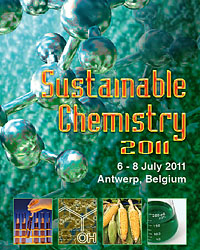 The first International Conference on Sustainable Chemistry has recently taken place at the University of Antwerp, organised by that Institution, represented by Professor Genserik Reniers, and the Wessex Institute of Technology (WIT), of the UK, represented by Professor Carlos Brebbia.
The first International Conference on Sustainable Chemistry has recently taken place at the University of Antwerp, organised by that Institution, represented by Professor Genserik Reniers, and the Wessex Institute of Technology (WIT), of the UK, represented by Professor Carlos Brebbia.
Chemical products make an irreplaceable contribution in every aspect of our modern-day lives. Chemical processes and products play an essential role in industrial sectors as diverse as agriculture, automotive, clothing, communication, construction, food, health, leisure, mobility, plastics, space, transport, etc. Our society depends on the wealth-creating aspects of industrial chemistry.
Societal expectations and the depletion of natural resources are pushing towards chemical processes becoming cleaner, more efficient, less consuming, safer and more secured. The ecological footprint of chemical products needs to be decreased.
Sustainable chemistry being concerned with the development of sustainable chemical products and processes and thereby integrating economic, environmental and social performance, can provide an answer to these major challenges.
The technological and managerial objectives of scientific and industrial research and activities are quite straightforward; decrease the use of energy and fossil materials, develop clean, safe and secured processes, produce useful, safe and sustainable products, develop a long-term scope for transportation activities, etc., always taking factors such as cost-effectiveness, eco-efficiency and inherent safety into consideration.
The Sustainable Chemistry conference provided an interdisciplinary forum with technological and managerial presentations in an attempt to tackle successfully all the new chemistry paradigms.
Opening Address
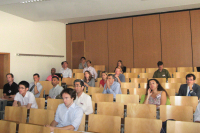 Professor Carlos Brebbia opened the meeting welcoming the delegates in this name of his Institute, explaining the importance of these meetings in relation to the objectives of WIT, i.e. the dissemination of knowledge, with particular emphasis on interdisciplinary activities.
Professor Carlos Brebbia opened the meeting welcoming the delegates in this name of his Institute, explaining the importance of these meetings in relation to the objectives of WIT, i.e. the dissemination of knowledge, with particular emphasis on interdisciplinary activities.
Professor Brebbia explained that the research carried out at WIT’s Campus in the New Forest is focused on the development of advanced computational methods and trying to apply them to a wide variety of problems. This leads to working in multidisciplinary research groups, and includes collaboration with a wide variety of industrial users. At present, most of the Institute’s research is being applied in naval, engineering, aerospace and offshore applications but also encompasses problems with food contamination, human health, new industrial processes and many others.
Over the years – Professor Brebbia said – WIT has developed strong links with a substantial number of well-known institutions all over the world, and has participated in many joint activities.
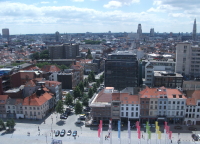
Its academic publishing division, WIT Press, has a very active programme. All conference books are published in digital and paper formats and widely distributed around the world. The papers are also archived online, where they are permanently available to the international scientific community. WIT Press also publishes a series of other books, including a substantial number of interdisciplinary volumes. Recently, Carlos explained, WIT Press has launched four Journals to cater for multidisciplinary fields of research, which are not well-covered by other commercial publishers.
WIT aims to collaborate rather than compete with University Institutions, aiming to act as a forum for communication amongst different fields. This is carried out as well by a series of courses that take place at its New Forest campus.
Keynote Addresses
The conference benefited from a series of keynote addresses by well-known colleagues from Belgium;
‘Possibilities and limitations of LCA for the evaluation of soil remediation and cleanup’
by Valerie Cappuyns from Hogeschool-Universitat, Brussels
‘Biometals and environmental quality’
by Willy Verstraete, Ghent University
‘Absorptive applications for a sustainable chemistry’
by Joeri Denayer, Free University of Brussels
Invited Presentations
In addition, there were other invited presentations as follows;
‘Green chemicals and 3rd generation fuels from lignin and hemicelluloses’
by Jean Michel Lavoie, University of Sherbrooke, Canada
‘Strong bond cleavage promoted by silyl group migration in a coordination sphere’
by H. Nakazawa, Osaka City University, Japan
‘How to enhance sustainable chemistry in a non-technological way?’
by Genserik Reniers, University of Reniers, Belgium
Special Session on Smart Processing Technology and Sustainability
A further attraction at the conference was the special session on Smart Processing Technology and Sustainability arranged by Professor Makio Naito of the Smart Processing Research Centre in Japan. The sessions started with his special address, entitled ‘Smart Powder Processing for Energy and the Environment’ and was followed by the following presentations;
‘Advanced technique to reduce emissions of fine particulate matter using ultrasounds’
by Benjamin Bergmans, Attache Cellule Emission Atmospherique, Belgium
‘Measurement and analysis of fine particulate matters (PM10/PM2.5) and condensable nanoparticles emission from stationary sources’
by Hidekiro Kamiya, Tokyo University of Agriculture and Technology, Japan
‘Reduction technology of carbon dioxide emissions from a coal powered generation system’
by Hiseo Makino, Energy Engineering Research Centre, Japan
‘Catalyst design with porous functional structures’
by Jasper Van Noyen, Flemish Institute for Technological Research (VITO), Belgium
‘Development of photonic and thermodynamic crystals conforming to sustainability conscious materials tectonics’
by Susho Kirihara, Smart Processing Research Centre, Japan
Excursions and Conference Dinner
The conference offered many opportunities for informal discussion in a friendly atmosphere. In addition to coffee breaks, the delegates were offered complimentary lunches and were invited to participate in two complimentary excursions to strengthen their contacts while helping them to appreciate some of the sights of Antwerp. The first was a Harbour Cruise that took place during the afternoon of the first day, while at the end of the conference the delegates were taken on a guided walking tour to show some of the historic buildings of the city.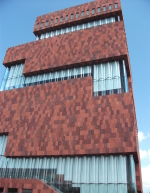 All the delegates and their partners were invited to participate in the Harbour Cruise. The Port of Antwerp is the second largest port in Europe and amongst the top ten in the world. It has been a source of wealth for the city over centuries and nowadays is very productive and profitable. The current port is located north of the city centre and covers about 13,500 hectares. It accommodates large ocean going ships and pleasure cruisers. It has many docks and drawbridges and around the clock activity. Anyone who has seen the port can see why Antwerp has been called a metropolis throughout the centuries. The Harbour Cruise took the delegates through several docks including the Delwaid dock where the large ships are anchored. The excellent weather and friendly environment helped to make this a special occasion.
All the delegates and their partners were invited to participate in the Harbour Cruise. The Port of Antwerp is the second largest port in Europe and amongst the top ten in the world. It has been a source of wealth for the city over centuries and nowadays is very productive and profitable. The current port is located north of the city centre and covers about 13,500 hectares. It accommodates large ocean going ships and pleasure cruisers. It has many docks and drawbridges and around the clock activity. Anyone who has seen the port can see why Antwerp has been called a metropolis throughout the centuries. The Harbour Cruise took the delegates through several docks including the Delwaid dock where the large ships are anchored. The excellent weather and friendly environment helped to make this a special occasion.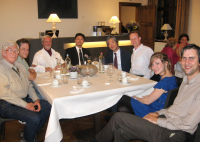 The conference dinner took place in the University Club which is located in a beautiful XVI Century building. The excellent company, together with an outstanding menu and good wine, added to the enjoyment of the occasion. The delegates were able to experience a series of special dishes, starting with a cold soup consisting of a bed of carrot and paprika with avocado at the centre, followed by salmon accompanied by a variety of vegetables and ending with a unique combination of ice cream and pannacotta. Carlos proposed a toast to the conference and all participants and expressed the gratitude of the organisers for the presence of delegates from so many different countries.
The conference dinner took place in the University Club which is located in a beautiful XVI Century building. The excellent company, together with an outstanding menu and good wine, added to the enjoyment of the occasion. The delegates were able to experience a series of special dishes, starting with a cold soup consisting of a bed of carrot and paprika with avocado at the centre, followed by salmon accompanied by a variety of vegetables and ending with a unique combination of ice cream and pannacotta. Carlos proposed a toast to the conference and all participants and expressed the gratitude of the organisers for the presence of delegates from so many different countries.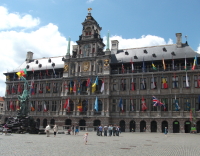 At the end of the conference the delegates were invited to take part in a guided walking tour of the city, starting from the central station. Along the way, they encountered many of the things that made Antwerp a unique city; old mansions, large new office buildings, department stores and malls, theatres and cinemas, schools, public transport systems, renown hotels, restaurants and typical cafes.
At the end of the conference the delegates were invited to take part in a guided walking tour of the city, starting from the central station. Along the way, they encountered many of the things that made Antwerp a unique city; old mansions, large new office buildings, department stores and malls, theatres and cinemas, schools, public transport systems, renown hotels, restaurants and typical cafes.
The route ran chronologically, through the Meir Street with its beautiful 18th century Palaces, the Rubens house and the historical centre. It continued along the Bourlaschounburg, the Trade Fair, the Green City and Glove Market, where the narrow streets are a reminder of a distant past. The walk ended at the first major inland port and the roots of the city, the Suikerrui and the Scheldt rivers.
The success of the conference will ensure its being reconvened in 2013 in a place and at a date to be shortly decided.
Publication of Papers
The proceedings of Sustainable Chemistry, 272pp (Print ISBN: 978-1-84564-558-8; Online ISSN: 1743-3541) are available in paper and digital format from WIT Press priced at £117/US$234/€164. Orders can be placed on the WIT Press web site at www.witpress.com or by email: This email address is being protected from spambots. You need JavaScript enabled to view it., telephone: +44 (0) 238 029 3223 or fax: +44 (0) 238 029 2853.
Papers from the conference will also be hosted online at the WIT eLibrary as Volume 154 of WIT Transactions on Ecology and the Environment (Online ISSN: 1743-3541). For more details visit the WIT eLibrary at http://library.witpress.com


 Wessex Institute
Wessex Institute